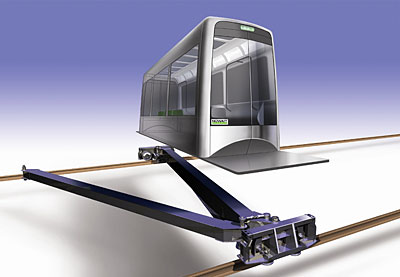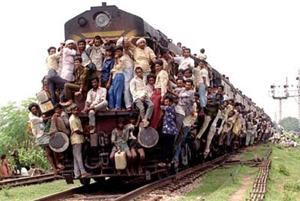BACKGROUND
WORLD POPULATION AND TRANSPORT
The world population is today 6 billion and it is projected to double until year 2050. At the same time, urbanization is increasing, which means that the cities around the world will have more than 6 billion more people compared to what they have today. Today about 3 billion live in cities, this means that the transport in the cities will increase by 200% during the period. The increase is particularly high in developing countries that also produce most of the population growth. These markets have serious financial limitations and current mass transit solutions are too expensive. The result is buses and cars, with traffic congestion, pollution and non-functioning cities at large.
In the developed world, population growth is low, but pollution, green house effects and CO2 emissions are catching the attention in all sectors of society. Existing mass transit systems are in operation, but relatively few people are using them, due to general inconvenience.
Non-availability
Here the problem is the non-availability of competitive low capacity solutions that can collect and distribute passengers with competitive and realistic waiting times and walking distances. Since this link is largely missing in mass transit solutions, the constructed systems have low utilization, they are too expensive to build and the service frequency is too low to give the passenger satisfaction. The result is that the car still is considered the preferable means of transport, even if it is expensive to park in the city and traffic jams actually make the travel time long.
CONCEPT
ESSENTIAL PARAMETERS FOR A SUCCESSFUL MASS TRANSIT SYSTEM:
1) Low construction cost
2) Low operating cost
3) Less waiting
4) High capacity
5) Sustainability
A competitive solution must satisfy all conditions; otherwise it will not be profitable to the passenger and to the society.
Looking at a traditional subway system; it must be inefficient to build a 40-ton car to transport 10 tons of people and to accelerate and decelerate these 50 tons every few minutes day out and day in. This takes energy, but it also takes heavy power propulsion, designed to handle 40 tons of no use.
The high vehicle- to passenger weight ratio also means that the infrastructure and the civil works have to be designed for high peak loads. Consequently the structures are heavy and expensive and most of the time they are unused.
These fundamentals give a clear direction;
a) Move the passengers continuously in order to; reduce waiting times, utilize the infrastructure as much as possible and reduce the dead weight to passenger weight relation.
b) Minimize the operation cost and create sustainability by energy efficient and driverless system solutions. Especially, keep the vehicle weight as low as possible by moving unnecessary vehicle mounted equipment to the stationary part of the system.
Nowait Transit Has Three Superior Motives
1. Performance and capacity
The continuous operation provides immediate access and high capacity. Since the entire track is filled with cars in continuous motion the passengers never have to wait at the stations. The maximum capacity exceeds 80 000 passengers per hour and direction.
The underlying principle function of this invention is to achieve a reduction of the travelling speed at the stations by a reduction of the length of the NOWAITTRANSIT® vehicle floor area through a 90-degree horizontal folding. By this method, the speed is reduced by a factor of approximately 10.
The speed reduction principle at the stations is shown in the first image. When the cars are travelling in the length-wise direction, the speed is high. As the vehicles fold, the speed is reduced. When the cars are completely folded, the passengers can safely enter and exit the cars at the ends, while they are moving at low speed. An additional speed buffer for safe ingress / egress is a moving walkway that runs parallel with the vehicles along the platform. The method provides feasible availability for disabled passengers.
Station distances can be reduced, the available space for passengers is increased due to the considerably higher transport capacity, travelling over ground with a scenic view and the fact that the passenger never has to wait will make NOWAITTRANSIT the preferred choice for city transportation.
2. Low construction and operational cost
The NOWAITTRANSIT concept is the result of a systematic review of a great number of various existing and some new technologies and system criteria. The target has been to find an overall better balance between technical and economical performance compared to conventional mass transit systems.
Due to the continuous operation the load is evenly distributed along the track giving that all structural elements do not have to be designed for high peak loads. The total weight of a NOWAITTRANSIT ® vehicle is less than 4 tons. Also by building the system over ground, using standardised components, the total construction cost is about 20 % compared to a conventional subway system.
By letting the cars turn 90 degrees sideways simultaneously as they are moving up a hill while entering a station, the velocity is reduced. The motion energy is regained as the cars move down a hill on the opposite side of the station. The method gives that there are no energy losses caused by mechanical braking. It is a driverless system and the maintenance is kept to a minimum due to few moving components. The result is that the operational cost is about 20 % of a conventional subway system.
The low construction and operational cost of the NOWAITTRANSIT system creates profitability based on normal mass transit fees alone, which opens for Private – Public – Partnership, PPP.
3. Social concerns
There is little noise and there are no hazardous particles caused by mechanical braking giving a clean environment both inside and outside the vehicles and stations. Since the cars are connected no signal system is required and collisions between cars are impossible. The track is enclosed, the cars are moving slowly and close to each other at the stations, so there is no possibility of falling or jumping in front of a moving car.
The energy consumption is so low (5 Wh/ seat km) that the whole system can be run solely by solar power. This will create the world’s first zero emission mass transit system.
See How It Works.

